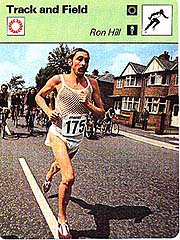By Roger Robinson - As featured in the JulyAugust 2010 issue of Running Times Magazine
It took a volcanic eruption to stop Ron Hill coming to Boston in April for the 40th anniversary of his victory. Nothing less could get in the way of Britain's still-intrepid European, Boston and Commonwealth marathon champion of 1969-70.
Before his marathon fame, however, the first real sign of that impending greatness came at a distance that was unknown in those days: the half marathon. At Freckleton, Lancashire, in 1964, Hill won a new race at the oddball distance in 1:04:00, more than hinting at the sub-2:10 marathons to follow.
"The half marathon is a great distance, as you can push yourself almost flat out without the risk of blowing up," Hill told me by email.
Forty-six years later, Hill's time still stands as the Freckleton course record. He even ran there again in 2009, at age 70, in 1:49:59.
"That was my final half marathon, on the same course where I ran my first," he reflected.
The race Hill inaugurated is now (by my unofficial count) the third-oldest continuing half marathon in the world. Granddaddy is the Route du Vin in Luxembourg, founded in 1961, followed by the Lincoln Memorial Half Marathon in Springfield, Ill., first run in April 1964. Other venerable continuing American half marathons include the San Dieguito in Rancho Santa Fe, Calif. (1968), and the YMCA in Phoenix East Valley, Ariz. (1969). These were the pioneers.
Now the half marathon is the growth event of our time, the distance by which increasing numbers of runners define themselves. It came fully into its own in the late 1970s. The United States led the world in creating great half marathon races and producing fast runners. Four American women and five men set world records on American courses. ( They were Michiko Gorman 1:15:58, 1978; Ellison Goodall 1:15:01, 1979; Patti Catalano 1:14:03, 1979; Joan Benoit, who broke the record four times, her fastest 1:08:34 in 1984; Kirk Pfeffer 1:02:32, 1979; Stan Mavis 1:02:16, 1980; Herb Lindsay 1:01:47, 1981; Paul Cummings 1:01:32, 1983; and Mark Curp, 1:00:55, 1985.) Curp had tuned up for his stellar Philadelphia Distance Classic performance with a 1:03:48 course record on home turf in the Hospital Hill Run in Kansas City.
Regularly cited as one of the best races in the country, and one of our oldest half marathons, it typifies the distance's transformation from obscure novelty into the leading edge of this century's running boom. Beginning in 1974 as a 6.8-miler, Hospital Hill quickly moved up to 13 miles, and became a certified half in 1980.
It began to attract international stars like Priscilla Welch. Numbers soared up, course records tumbled down, and crowds flocked to forum speakers like George Sheehan. Now the race is booming again. Yet it is not for softies.
"The best tip is start out conservatively. That lessens the effect of the hills and the possible humidity," Curp says.
I agree. In 1980, with a tourist's Amtrak pass across America, I stopped off in a sweltering Kansas City and (thanks to a cautious start) ran a 1:10:38 masters record for third place overall. For me that counts as History--the most memorable half marathon I ever ran.





 ShareThis
ShareThis